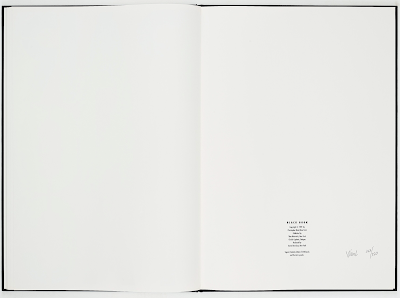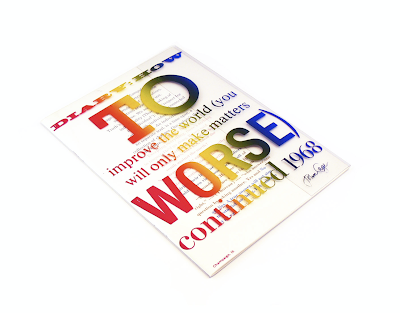John Cage
Diary: How to Improve the World (You Will Only Make Matters Worse)
Los Angeles, USA: Siglio Press, 2015
176 pp., 6 x 8.5", hardcover
Edition size unknown
Poets Clark Coolidge and Michael Palmer met at the legendary Vancouver Poetry Conference in 1963, a three week summer session course at the University of British Columbia, organized by Warren Tallman and Robert Creeley, that featured Allen Ginsberg, Margaret Avison, Charles Olson and numerous others. "We took to each other instantly," remembers Palmer, "and started immediately talking about jazz, John Cage, and composing aleatory works on the typewriter. The musical connection--both jazz and new music--was an immediate opening for both of us because we were both very much involved in that world.”
Their shared interests led to the forming of the short-lived periodical Joglars (1964 - 1966). Primarily a poetry magazine, the publication also included works by contributors who crossed over into other fields, such as filmmaker Stan Brakhage, concrete poet Ian Hamilton Finlay and Fluxus artist Jackson Mac Low.
Coolidge solicited a contribution from Cage for the third (and final) issue, who responded with the first instalment of what would become one of his most celebrated lectures, Diary: How to Improve the World (You Will Only Make Matters Worse).
"Since Coolidge's magazine was printed by photoset from typescripts," Cage wrote in the forward to A Year From Monday, which reprinted the work, "I used an IBM electric typewriter to print my text. I used twelve different type faces, letting chance operations determine which face would be used for which statement. So, too, the left marginations were determined, the right marginations being the result of not hyphenating words and at the same time keeping the number of characters per line forty-three or less."
Siglio Press, the LA-based independent publisher founded by Lisa Pearson in 2008 with a mandate to produce “uncommon books at the intersection of art & literature” released a new version of Diary in 2015. The hardcover book collects - for the first time - all eight completed parts of the Diary, which was written and published over a sixteen-year period. Co-editors Joe Biel and Richard Kraft stay true to the spirit of Cage's chance-determined layouts with a lovingly produced volume, with coloured texts and a letter-pressed cover.
Cage described these writings "a mosaic of ideas, statements, words and stories. It is also a diary." In addition to the typeface and layout (and later colour), the length of the texts were also the result of Cage’s oft-used chance determinacy procedures, including tossed coins and consulting the I Ching:
"For each day, I determined by chance operations how many parts of the mosaic I would write and how many words there would be in each. The number of words per day was to equal, or by the last statement written, to exceed one hundred words."
These techniques, best known in Cage’s musical compositions, push the Diary into the category of constrained writing, but the insights, anecdotes and quotations (often truncated) are so rich that the conceit does not overwhelm the reader.
In much the same way that he did not object to incidental sounds interfering with his music, Cage's playful meandering here includes excerpts from the radio, television and overheard conversation, alongside quotations from books and newspapers, recipes even. These are randomly spliced and often unattributed. The collaged or cut-up writing style (which Cage refers to as “a mosaic”) was popularized by William S Burroughs, who learned it from artist and writer Brion Gysin. It can be traced back further, to Dadaist Tristan Tzara, and even Lewis Carroll:
“For first you write a sentence,
And then you chop it small;
Then mix the bits, and sort them out
Just as they chance to fall:
The order of the phrases makes
No difference at all.”
- Poeta Fit, Non Nascitur, 1881
While the stories are decidedly more personal than Cage’s other writings, it is a diary in the loosest sense of the term, in that it slights chronology and features very little in the way of confessional biography. There are no candid passages, for example, about choreographer Merce Cunningham, Cage’s romantic partner for half of his life. Even a figure as radically unconcerned with convention such as Cage was still coy about his sexuality in pre-Stonewall America, but it is shocking how many contemporary biographies still describe their relationship as one of mere “collaborators”.
Many of Cage’s favourite subjects are included in the text(s), such as Zen Buddhism, chess, mushrooms and music. He muses on a wide variety of subjects, including composing:
"He wanted me to agree that the piano tuner and the piano maker have nothing
to do with the composition. The younger ones had said: Whoever
makes the stretcher isn’t separate from the painting."
education:
“Encouraged, instead of frightened, children could learn several languages before
reaching age of four, at that age engaging in the invention of their own languages.
Play’d be play instead of being, as now, release of repressed anger.”
utopia:
"It's impracticality is no longer to be assumed."
and the new arts:
"We still have everything we used to have. The Mona Lisa's still with us, for
instance. On top of which we have the Mona Lisa with a moustache".
This is one of several references to Marcel Duchamp, who Cage counted as a close friend and chess partner. He frequently mentions other artists, composers, writers and thinkers, including Henry David Thoreau, Arnold Schoenberg, Marshall McLuhan, Margaret Meade, David Tudor (the pianist who first performed Cage’s legendary silent composition 4’33”), Jasper Johns, James Joyce and Buckminster Fuller. In the forward to M (Writings ’67 - ’73), Cage cites the latter as the project's inspiration:
“I began the Diary optimistically in 1965 to celebrate the work of R. Buckminster Fuller, his concern for human needs and world resources, his comprehensive scientific designs for making life on earth an unequivocal success, his insistence that problem solving be continuously regenerative.”
Four more instalments of the Diary appeared in M, after first being published in a variety of important artists’ periodicals.
In June of 1966, Cage performed the first text at the International Design Conference in Aspen, Colorado, and it was reprinted in the the Spring 1967 issue of Aspen Magazine. Founded by Phyllis Johnson, Aspen was a multi-media periodical that billed itself as “the first 3-dimensional magazine”. Ten issues were published between 1965 and 1971 as either boxes or folders, which contained audio recordings, films, posters, artist multiples and other objects, alongside texts by authors, poets and artists. Johnson commissioned guest editors and designers, including Andy Warhol, Dan Graham, Jon Hendricks, Brian O’Doherty and Angus MacLise.
Diary was included in Issue #4, designed by Quentin Fiore, and titled The McLuhan Issue, which showcased the ideas of cultural theorist Marshall McLuhan (who had recently collaborated with Fiore on his most recent book The Medium is the Massage). Cage cites McLuhan on the second page of the Diary (“As McLuhan says everything happens at once”), the first quotation after Kierkegaard. Other McLuhanisms liberally pepper the text. The McLuhan Issue also included several posters, a flexi-disc record of electronic music, an article about a nature trail for the blind and a folder of advertisements, which includes a Something Else Press newsletter.
In addition to publishing possibly the most important series of artists’ books ever (including Cage’s Notations), the Something Else Press produced a series of twenty staple-bound booklets under the name The Great Bear Pamphlets. Many of the contributors were involved with either Fluxus, Happenings or experimental poetry (or all three), and several were once students of Cage. The series included projects by George Brecht, Robert Filliou, Al Hansen, Allan Kaprow, Alison Knowles, Claes Oldenburg, Nam Jun Paik, Diter Rot and Emmett Williams. The third part of Cage’s ongoing serial Diary was published as Great Bear #11.
The following year another Diary entry (subtitled Continued) would appear as part of Issue #4 of S.M.S., William Copley’s portfolio periodical which took a very similar approach to Aspen. The August 1968 issue also featured contributions by Arman, James Lee Byars, Christo, Roy Lichtenstein, Lil Picard and La Monte Young. Cage’s Diary was printed on heavy stock paper with a beautiful mylar cover printed with colored split-fountain typography (see below).
Other periodicals to publish the Diary entries include Tri-Quarterly (1969), Liberations (1971) and New Literary History (1971). When the texts were compiled in X, M and A Year From Monday, by the Wesleyan University Press, they were reproduced in black and white. The Siglio editors, though, were drawn to the use of colour in the Great Bear Pamphlet, as they recount in the afterword:
"Dick Higgins and Alison Knowles, in collaboration with Cage, employed a two-colour process (using various mixtures of red and blue) to add another chance-determined layer to the text. The use of colour was an additional step which imbues the text with greater physicality, something that seems both musical and sculptural. The varying typefaces, the patterns of indentation, and - most dramatically - the shifts in colour give the words a spatial dimension. These qualities ask us to hear the words as well as see them."
They go on to explain the process they used to determine the layout, colour and typefaces for the text, and the questions they asked themselves to ensure the end result would turn out well (based on Cage's belief that the success of chance determinacy is based on the quality of questions being asked).
The producers of the John Cage tribute CD A Chance Operation faced a similar dilemma in 1993. How could they honour the spirit of Cage with a recording, when Cage himself famously didn't own a record player, preferring to listen to the sounds of traffic? Their solution was to divide the dozen or so tracks into 99 sections so that the disc could be played continuously without interruption, or put on shuffle for an almost infinite set of possibilities.
Cage made a recording of the Diary in Maur, Switzerland in June of 1991, a little over a year before his death. The typography of the published versions determined the stereo distribution, microphone placement, and volume. On the resulting 8 CD box set, Cage's warm tone feels like a disembodied voice in your head. Prior to the Siglio volume, this was the only way to own the complete text.
Cage would continue to write and revise and reorganize the Diary throughout his life. He planned ten sections and was working on the 9th when he died in August of 1992. He notes in the forward to X: Writings ’79-’82 (which included the final Diary entries) that he was hoping to “find a way of writing which comes from ideas, is not about them, but which produces them.”
Diary: How to Improve the World (You Will Only Make Matters Worse) is out of print and sells for between $60 and $80 US on the secondary market. A second, soft-cover expanded edition is available from the publisher (see next post).


















































